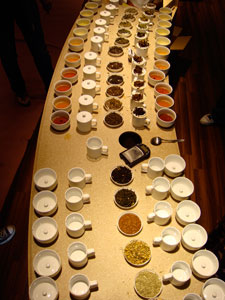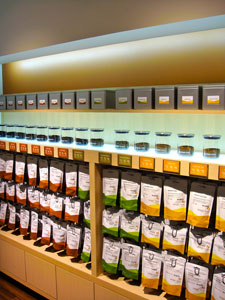The Long Bet: investing in the customer base





The Long Bet is something of a lost art form in today's economy. A few years ago everyone was bemoaning the short term thinking that resulted from quarterly earnings reports and the drive to maintain stock prices. Investing today is influenced more by minute-by-minute Twitter updates. Immediate results are a good thing, but, to paraphrase a statement made popular by author Jim Collins; "Good is often the enemy of great".
After two months of brick-and-mortar retail sales, Adagio has sold thousands of $2 sample packages of tea and not made a lot of money. This isn't good, but it IS great. It's all part of the Long Bet. Allow me to explain.
I am a product of the DOT COM era. Our collective goal was to identify low hanging fruit, find an investor, and get rich. This is possible, but it ignores the underlying truth that the best business results don't come from swooping in from the outside and grabbing the low hanging fruit. If it were that easy, everyone would do it. The best businesses are built by investing in what does not yet exist. To continue the analogy, this would mean buying the right land, hiring the right people, and planting the vines by the sweat of your own brow. This is the process by which we learn to CREATE low hanging fruit. This is the process by which gamblers become entrepreneurs, and entrepreneurs become business people.
The low hanging fruit in the tea business for the last couple years has been
1) Bottled iced teas
2) Selling decorative teaware to trinket buyers with disposable income
3) Riding the wave of interest in the health benefits of tea.
The bottled tea wave is currently crashing into the health benefit wave as consumers are realizing there's about as much tea in most iced teas as there is juice in Kool-Aid. Adagio planted some seeds six years ago and watered for a REALLY LONG TIME before the Anteadote line of organic, unflavored, unsweetened bottled teas took off. Today the product is paying huge dividends and the hardest part is keeping them in stock.
Decorative or traditional teaware sold to curious shoppers with money to spend is a great way to make a quick buck. I'll never bet against the conspicuous consumption habits of Americans, but this is a fickle customer base at best, and repeat business is limited.
Selling tea based on health benefits has worked really well, but is currently under extreme fire both by the FDA (example warning) and by scientific reality. Don't get me wrong, tea is great for you, and a good part of a healthy lifestyle. But we've seen a long string of "next big thing" products for weight loss, curing cancer, staving off diabetes, skin health, fighting allergies, etc. Smart consumers have a general sense that all that's a bit much.
So what is the "long bet" in tea? How about the fact that hot brewed tea is by far the most popular beverage in the world after water? Today most studies suggest that about 1/3 of Americans drink hot tea on a regular basis. Seems to me there's a pretty big population of consumers out there who would really appreciate a good cup of tea if they ever were introduced to one. I do NOT think that the best way to convert the tea curious is to sell them a $200 cast iron teapot or promise that a tea will cure their allergies.
The best way to convert the tea curious to tea lover is
A) Teach them how to properly steep a cup of tea
B) Engage them by brewing multiple teas of their choosing for free to demonstrate the differences and help them understand what they're looking at. Pre-brewed samples lack educational opportunities, don't make them more comfortable with the leaf, and don't help them understand how to do it at home.
C) Send them home with a lot of tea to try and most of their money still in their pocket. We're not looking for a big sale followed by buyers remorse (remember, this is the Long Bet.) We're looking for an enthusiastic tea drinker and a loyal customer.
In practice, this means spending a good deal of time with each customer and making a small sale. Letting them drink tea for free (not just a tiny sample) depresses tea-bar sales, requires a lot of space for cupping, a lot of equipment, a lot of dishes, and a lot of staff. Most importantly, it requires a lot of money.
Two months after opening our first store, labor costs are extremely high and the average sale is extremely low. That's not good. But what's great is our daily transaction count. See, I can control labor costs. I can make changes to pricing, merchandising and product mix to impact the average ticket. The one thing that's really hard, and really expensive to do, is get more people to walk through the door. At this point we are engaging the tea curious and building a long term, loyal customer base of tea lovers.
Most new tea shops (after a short honeymoon period in which the neighborhood comes out to investigate the new store) open to fewer sales than expected or hoped. They respond by minimizing labor costs - one of the few cost variables that can be easily controlled. As a result, customer engagement is limited, and sales are mainly to existing tea drinkers and more adventurous or determined customers. Most tea shops fail to properly attract, engage or capitalize on the majority of their POTENTIAL customer base. The Long Bet can be intimidating, but it's working.
So far, just under 60% of all tea purchases have been sample pouches of tea (most are $2 with a few as high as $7 for between 0.5 and 1 ounces of tea). The customer is still testing us out.
Interestingly, about 1/3 of customers are choosing to purchase our tea packaged in pyramid tea bags. This is another investment Adagio has made in introducing more people to tea. Every single tea in our regular collection (approx. 200 teas) is available either loose or in premium pyramid tea bags. The truth is that the pyramid bags cost roughly twice as much per cup of tea as the loose variety, but if 1/3 of customers are choosing this option there is clearly a strong demand. My hope is that by "speaking the customer's language", we can earn their trust and begin introducing them to other tea options and methods of preparation.
In my personal experience, and in talking to other tea entrepreneurs, it is extremely common for the average sale at a new store to start very low as customers test the water... or in this case the tea. Over the first year this average climbs steadily while the customer count often remains reasonably steady. Tea shops often see dramatic sales increases without dramatic increases in either labor or customer counts. This is the strategy, but it's the Long Bet... it takes time.
The key to success is a solid strategy, sufficient capital, and patience. Oh, and a hell of a lot of hard work. ;)
Adagio Teas
Twitter: @AdagioRetail
